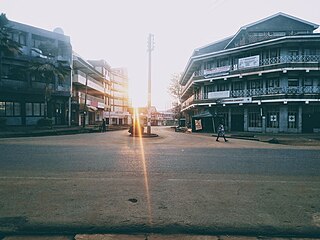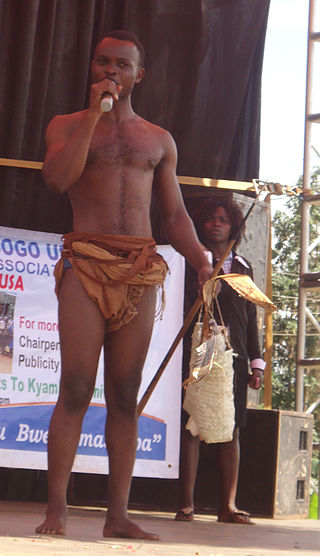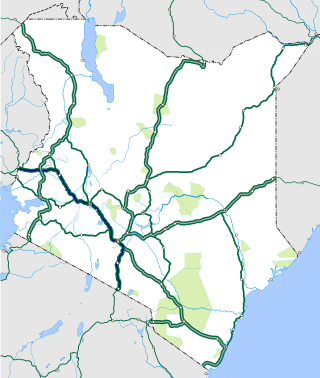Related Research Articles
Masaba (Lumasaaba), sometimes known as Gisu (Lugisu) after one of its dialects, is a Bantu language spoken by more than two million people in East Africa. The Gisu dialect in eastern Uganda is mutually intelligible with Bukusu, spoken by ethnic Luhya in western Kenya. Masaba is the local name of Mount Elgon and the name of the son of the ancestor of the Gisu tribe. Like other Bantu languages, Lumasaba nouns are divided into several sets of noun classes. These are similar to the genders in Germanic and Romance languages, except that instead of the usual two or three, there are around eighteen different noun classes. The language has a quite complex verb morphology.

The Luhya are a Bantu people and the second largest ethnic group in Kenya. The Luhya belong to the larger linguistic stock known as the Bantu. The Luhya are located in western Kenya and Uganda. They are divided into 20 culturally and linguistically united clans. Once known as the Kavirondo, multiple small tribes in North Nyanza came together under the new name Baluhya between 1950 and 1960. The Bukusu are the largest Luhya subtribe and account for almost 30% of the entire Luhya population.

The Bukusu people are one of the 17 Kenyan tribes of the Luhya Bantu people of East Africa residing mainly in the counties of Bungoma and Trans Nzoia. They are the largest tribe of the Luhya nation, with 1,188,963 identifying as Bukusu in the 2019 Kenyan census. They speak the Bukusu dialect.

Western Province was one of Kenya's seven administrative provinces outside Nairobi. It is inhabited mainly by the Luhya people. Quakerism is widely practised here. Kenya's second highest mountain, Mount Elgon is located in Bungoma District. The Kakamega Forest rainforest is part of the area. The province capital was Kakamega. After the 2013 general election, and the coming into effect of kenya's new constitution, provinces became defunct and the country is currently divided into 47 counties. Each county has its own government and therefore there is no central regional capital. Western Province became the Western region, comprising four counties: Kakamega, Bungoma, Vihiga, and Busia.

Bungoma town is the capital of Bungoma County in Kenya. It was established as a trading centre in the early 20th century. It is located in Kenya's fertile Western region and at the foot of Mount Elgon, Kenya's second-highest mountain. The town and the surrounding areas boast one of Kenya's highest average rainfalls, making Bungoma one of the nation's most important food baskets.
Luhya is a Bantu language of western Kenya.
The Gisu people, or Bamasaba people of Elgon, are a Bantu tribe and Bantu-speaking ethnic group of the Masaba people in eastern Uganda, closely related to the Bukusu people of Kenya. Bamasaba live mainly in the Mbale District of Uganda on the slopes of Mount Elgon. The Bagisu are estimated to be about 1,646,904 people making up 4.9% of the total population according to the 2014 National Census of Uganda.

The Masaba people, or Bamasaaba, are a Bantu people inhabiting the eastern Ugandan districts of Sironko, Manafwa, Bududa, Mbale, Namisindwa and Bulambuli. They are closely related to the Bukusu and Luhya of Western Kenya. They are mainly agricultural people, farming coffee, millet, bananas and sorghum on small-holder plots. Maize became popular with the coming of Europeans in the late 1890s.

Webuye, previously named Broderick Falls, is an industrial town in western region of Kenya and home to the Tachoni people. It is located within Webuye West sub county in Bungoma County, at the slopes of chetambe hill Kenya. Located on the main road to Uganda, the town is home to the Pan African Paper Mills, formerly the largest paper factory in the region, as well as East African heavy-chemicals plant. The area is heavily populated and is used mainly for subsistence agriculture. The town has an urban population of 42,642.

Bungoma County is a county in the former Western Province of Kenya with its capital in Bungoma town. It has a population of 1,670,570 of which 812,146 are males and 858,389 are females as per the 2019 census. The county has an area of 2,069 km2. It has nine constituencies, namely: Bumula, Kabuchai, Kanduyi, Kimilili, Mt. Elgon, Sirisia, Tongaren, Webuye East, and Webuye West.
Matungu is a small town in the Western Province of Kenya. It is located in the Kakamega County.
Misikhu is a rural town situated on the southern slopes of Mt Elgon, in Bungoma County, Kenya. Located ten kilometres north of Webuye town and towards Kitale, Misikhu serves as both an administrative and commercial hub.

Musikari Nazi Kombo is a Kenyan politician who serves as a nominated Member of Parliament.

The Maragoli, or Logoli (Ava-Logooli), are now the second-largest ethnic group of the 6 million Luhya nation in Kenya, numbering around 2.1 million, or 15% of the Luhya people according to the last Kenyan census. Their language is called Logoli, Lulogooli, Ululogooli, or Maragoli. The name Maragoli probably emerged later on or after interaction of the people with missionaries of the Quaker Church.
The Great Lakes Bantu languages, also known as Lacustrine Bantu and Bantu zone J, are a group of Bantu languages of East Africa. They were recognized as a group by the Tervuren team, who posited them as an additional zone to Guthrie's largely geographic classification of Bantu.

The Tachoni is one of the tribes that occupy Bungoma County, Kakamega County, Trans Nzoia County and Uasin Gishu County in the western part of Kenya, known for its gallant defense of the Chetambe in 1895 when resisting British rule. Tachoni people were masters at building forts such as Chetambe, Lumboka, and Kiliboti. It was their defiance of colonialism that led to the colonial government to put the entire region occupied by the Tachoni under administration of paramount chiefs drawn from Bunyala and Wanga communities.
The Kabras, or Kabarasi, are a subtribe of the Luhya people of Kenya. They reside in Malava in the Kabras Division of Kakamega District, which is neighboured by the Isukha, Banyala, Tsotso, and the Tachoni. The exact origin of the Luhya people is currently disputed, but there are historians who believe that the group came from Bethlehem and migrated to their present-day location by way of the so-called Great Bantu Migration.
Idakho, Isukha, and Tiriki are mutually intelligible Kenyan languages within the Luhya ethnic group. They are a set of languages closely related to some other Luhya ethnic groups like Maragoli, but less so in comparison to others, like Bukusu,Tachoni or Samia.
The Kisumu–Kakamega–Webuye–Kitale Road, is a rural road in Kenya. The road links Kisumu, in Kisumu County, to the towns of Kakamega, in Kakamega County, Webuye in Bungoma County, and Kitale in Trans-Nzoia County.

The Nairobi–Malaba Road, also Nairobi–Uganda Road or A104 Road (Kenya) is a major highway in Kenya, the largest economy in the East African Community. The road connects Nairobi, the capital and largest city in Kenya, with the border town of Malaba at the international border with Uganda.
References
- ↑ Bukusu at Ethnologue (18th ed., 2015) (subscription required)
- 1 2 Maho (2009)
- ↑ Jouni Filip Maho, 2009. New Updated Guthrie List Online
- ↑ Jeff Mielke, 2008. The emergence of distinctive features, p 141–142